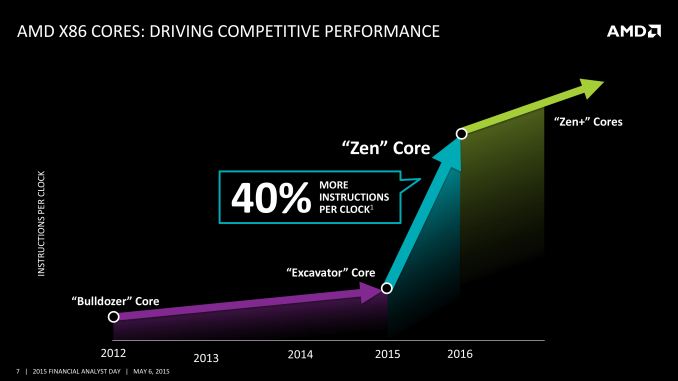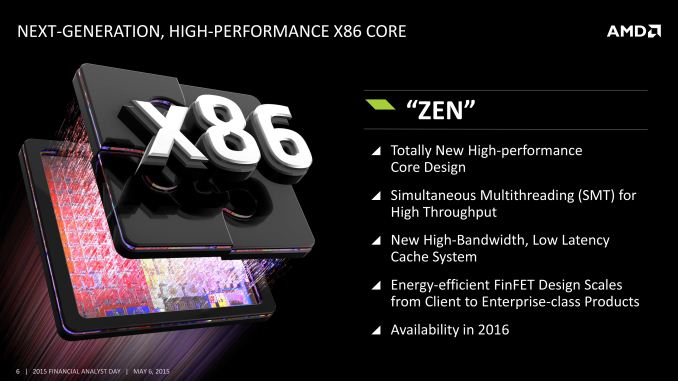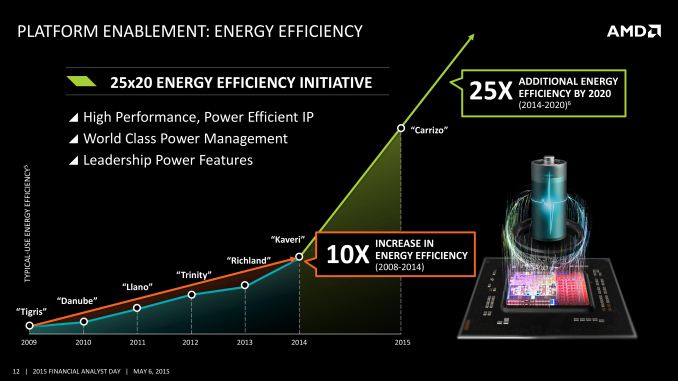AMD’s 2016-2017 x86 Roadmap: Zen Is In, Skybridge Is Out
by Ryan Smith on May 6, 2015 2:02 PM EST- Posted in
- CPUs
- AMD
- AMD FAD 2015
- Zen

AMD’s CTO Mark Papermaster just left the stage at AMD’s 2015 Financial Analyst Day, and one of the first things he covered was AMD’s CPU technology roadmap for the next couple of years.
The big question on everyone’s mind over the last year has been AMD’s forthcoming x86 Zen CPU, developed by Jim Keller’s group, and Papermaster did not disappoint, opting to address the future of AMD’s x86 plans first and foremost. AMD is not releasing the complete details on Zen until closer to its launch in 2016, but today they are providing some basic details on the CPU’s abilities and their schedule for it.
In terms of features, AMD once again confirmed that they’re aiming for significantly higher performance, on the order of a 40% increase in Instruction Per Clock (IPC) throughput. In a significant shift in threading for AMD’s x86 CPUs, Zen will also shift from Bulldozer’s Clustered Multithreading (CMT) to Simultanious Multithreading (SMT, aka Intel’s Hyperthreading). CMT is the basis for Bulldozer’s unusual combination of multiple integer cores sharing a single FPU within a module, so the move to SMT is a more “traditional” design for improving resource usage, and it means Zen will similarly have a more traditional resource layout. AMD is also labeling Zen’s cache as a “high-bandwidth, low latency cache system,” though at this time they aren’t quantifying just how that differs from the Dozer family’s cache.
Meanwhile AMD has confirmed that Zen will be shipping in 2016, and that it will be produced on a yet-to-be-named FinFET process. Our bet would be that AMD continues to use traditional partner (and spin-off fab) GlobalFoundries, who will be ramping up their 14nm equipment for next year as part of their licensing/partnership with Samsung to implement Samsung’s 14nm FinFET process. Zen at this time is AMD’s priority, to the point where the company is willing to push back the ARM K12 in order to get Zen out the door first.
Desktop users will be happy to know that the first Zen processor out the door will be AMD’s high-end desktop CPU (AMD was very deliberate in this, it’s not an APU). AMD will be aiming high and then cascading Zen down into APUs and lower-end products.
Said Zen CPU will use a new AMD platform – AM4 – which will also support DDR4. Unlike the Dozer family, all of AMD’s desktop CPUs will use the same AM4 platform/socket, so when AMD does ramp up their Zen APU, it too will be on AM4 and not its own socket, simplifying the process.
Finally, AMD’s roadmap for Zen over 2016-2017 calls for further improved Zen cores, “Zen+”, later on. Though the biggest jump for AMD comes from the transition from Dozer to Zen, the company is looking to push the envelope on IPC harder than they did with the Dozer family, projecting a higher increase in IPC over time than what we saw with the Dozer parts.
As for what this means for single-threaded performance, that remains to be seen. After having chased a lower-IPC/higher-clockspeed strategy in an attempt to do something different from Intel – the AMD that designed Bulldozer thought it wise not to try to beat well-funded Intel at their own game – the focus on higher IPC is arguably the correct move to make as the laws of physics have continued to keep 5GHz+ clockspeeds from being efficient enough to be practical. That said, single-threaded performance is a combination of IPC and clockspeed, so to be competitive with Intel AMD needs to deliver higher IPC while maintaining relatively high clockspeeds, and the latter is not something AMD is disclosing this early in the process.
Finally, we’ll note that this roadmap is empty of any mentions of project Skybridge. CEO Lisa Su has commented that AMD has decided to change their focus away from Skybridge based on customer feedback. Customers were telling AMD that they didn't necessarily need socket compatible solutions, so AMD is going to work on differentiated solutions. That said, given that Skybridge was announced last year and planned for 20nm, I suspect that it has also become a victim of the short lifespan (and underperforming nature) of 20nm, leading to it being downplayed in favor of 14nm prodcts.
Meanwhile also absent was any further mention of AMD's Cat cores. Zen would appear to be AMD’s top-to-bottom x86 core, a significant departure from an AMD who previously wanted separate designs for the 10W-100W market and sub-10W markets.














59 Comments
View All Comments
Crunchy005 - Wednesday, May 6, 2015 - link
A lot of the thinner laptops mostly came not from CPU innovations but Intel getting onto OEMs about a standard for ultrabooks.Also you touch on some of my later points so you didn't read first line. Way to make yourself look like a jerk.
Yes the iGPU is about the only thing they have made gains in lately. intel HD 4000 to 5000 was only a 50% gain in benchmarks, the real world numbers show something around 15% on average.
http://www.anandtech.com/show/7072/intel-hd-5000-v...
chizow - Wednesday, May 6, 2015 - link
How do you think that new standard for Ultrabooks came about? Because Intel was packing MORE performance into SMALLER thermal envelopes. As someone who has spent time troubleshooting and repairing these laptops, it is easy to see, these advancements are made possible mainly through CPU innovations. Lower TDP CPUs, smaller cooling solutions, smaller batteries, thinner laptops.The only one who looks like a jerk is you when you are comparing Intel graphics in a TDP limited mobile situation. Or were you just trying to look dishonest?
HD4600 in 4690/4770 is 20 EUs, and is almost 2x faster than the HD3000 with 12 EUs in the 2500K
http://www.anandtech.com/show/8227/devils-canyon-r...
HD4600 in 4770K again is 20 EUs, compared to the 16 in HD4000 in 3770K, only 25% more and you see, in non-TDP limited scenarios, you see nearly 25% scaling.
http://www.anandtech.com/show/6993/intel-iris-pro-...
So yeah, you were wrong again, real world benchmarks scale just fine.
Crunchy005 - Thursday, May 7, 2015 - link
Wow, those AMD APU numbers are nicely above the best intel iGPUs. But this is about just intel's progress form one generation to the next. A lot of the gains you are talking about are very specific to the game. Yes they got a nice improvement in Bioshock: infinite, but not as much in metro: last light. in my experience intel graphics doesn't hold up accept at the bottom line settings and lower res.If you look at the Benchmarks here
http://anandtech.com/show/7677/amd-kaveri-review-a...
Iris pro pulls ahead in some games but the Apus average 68 FPS where as iris pro was averaging 78 in Bioshock, but if you look at minimum frame rate on the same game the minimum for the APUs is 30 and iris pro is 6. Thats terrible so under stress the iris pro becomes unplayable at the performance(low) settings on Bioshock where as the APUs never go below 30 FPS. To add to this the Intel HD 4600 shows average playable frame rates of 45 FPS and minimum frame rates at almost 22 FPS. How is iris pro an improvement on that, it looks like it went wrong somewhere, yeah it can peak when there is no stress but as soon as something happens bye bye frames.
Now to be fair it does seem to be game specific as well, it doesn't perform as poorly in some other games but it does seem to have a higher average - minimum frame rate difference than the 4600 and the APUs, consistency matters.
chizow - Thursday, May 7, 2015 - link
Yes so now you see exactly where Intel's innovation has been as they address their biggest threat. They are closing in on AMD APU graphics performance while blowing APU CPU performance away to the point they will have both aspects in their favor. That's where Intel's innovation has been regarding desktop CPUs. And as we have seen in mobile, they continue to drive the TDP floor down while maintaining higher performance than anything else in that class. And on the enterprise side of things, they have monstrous 16-core Xeon-EPs. So yes, while it appears things have slowed down on the desktop, that is only because Intel's TDP and transistor budgets are being put towards what they view as their biggest risk markets.I still can't complain though, in the years since Intel swayed me to their camp with Core 2 Duo, I've still managed to have meaningful upgrades for $300 or less: E6600 > Q6600 > i7 920 > i7 4770K > i7 5820K. All fantastic and meaningful upgrades. Not bad for a monopoly with no competition!
Novacius - Wednesday, May 6, 2015 - link
AMD doesn't want to get in phones and low cost tablets. Core can scale from 5W up to 140W. Zen could also do that, I suppose.RussianSensation - Wednesday, May 6, 2015 - link
Exactly. Some people are just clueless as they expect a company with 1.77B market cap to compete with Intel with 154B. It's amazing AMD is still alive at this point. AMD's strategy for smartphones/mobile is the K12 not Zen.chizow - Wednesday, May 6, 2015 - link
No, some people are just clueless and ignorant to the fact AMD wasn't always a 1.77B market cap company (try $12Bn at the time of ATI merger). Many of the decisions they made in the last 9 years since then have led them to their current predicament, including the decision to ignore netbooks and sell off their mobile handheld division to Qualcomm. But they do seem to care, since they keep churning out low-end APUs that are supposed to compete in this <15W market, yet we haven't seen them in any noteworthy devices.Novacius - Wednesday, May 6, 2015 - link
In the future, they'll invest even less in that market. There will be only APUs for Socket AM4 and FP4, not small sockets or cat cores even more. AMD lost market share due to Intel's "contra revenue" program according to Lisa Su.chizow - Wednesday, May 6, 2015 - link
Which is nonsense, because Intel's contra revenue program couldn't steal market share from a market AMD did not exist in. That's actually quite funny that AMD is blaming contra revenue for their lack of presence in the mobile/tablet market lol.testbug00 - Thursday, May 7, 2015 - link
Those low end APUs (Bobcat, Jaguar) are what has kept the lights on at AMD for the past few years. Without those, AMD likely would have gone under a year or two ago.